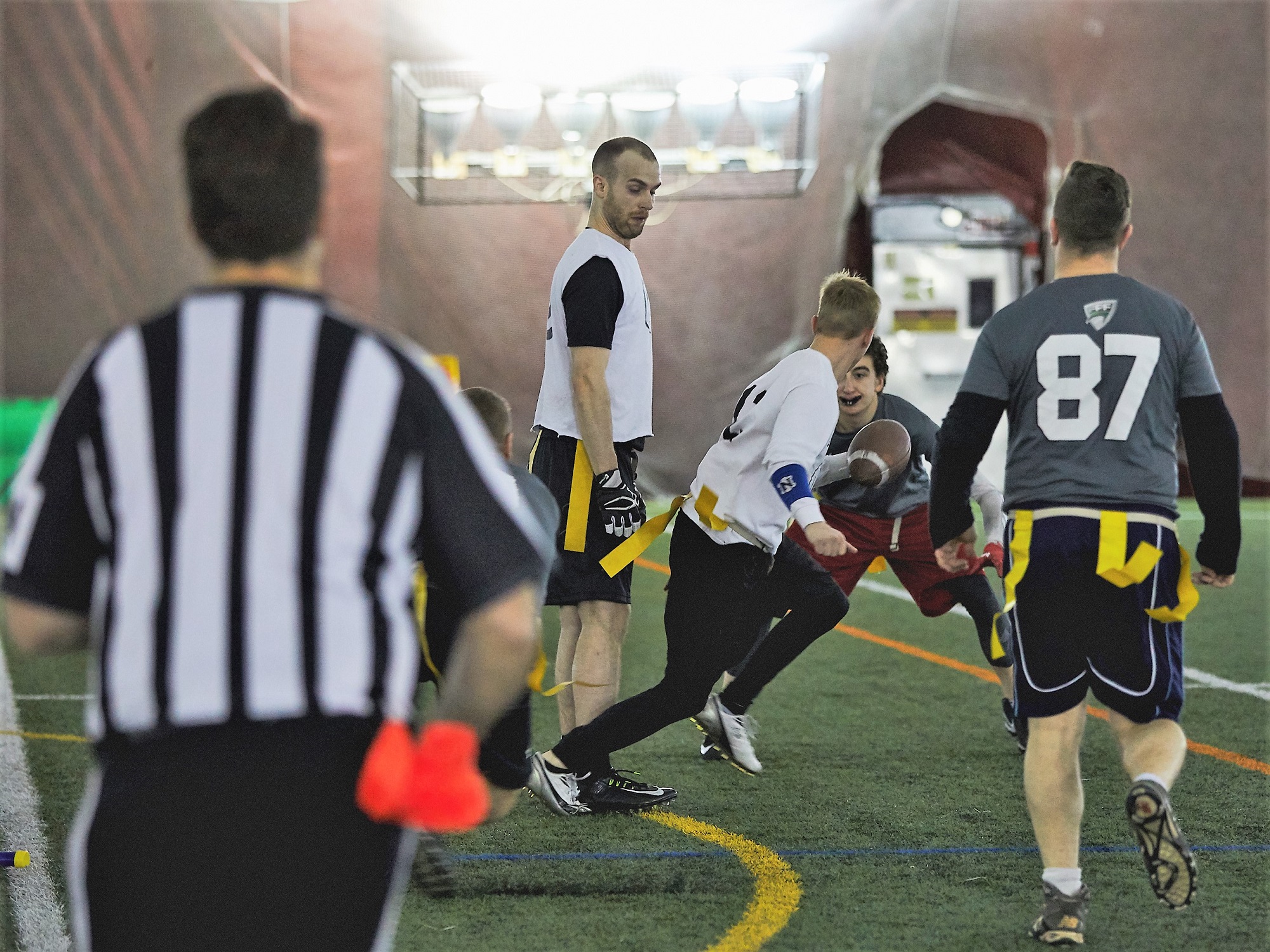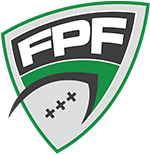Behind Enemy Lines: Positioning

We thought we would begin this third edition of the article with our first write in question which can generally be described as “getting to the goal line”. Upon further reflection, we found that we get asked questions rather frequently about the process for ruling a player in or out of bounds, a touchdown or short of the goal line, or first down or not on a critical 4th down play.
“How can officials rule on a touchdown if they are not on the goal line, and are far away?”
So to kick things off, you’ll recall from the first article that we are two officials with a lot of ground to cover. In order to do so effectively, we must be active in our movements, reading of the play, and most importantly, communicating with our partner. Let us look at some specific examples of key plays.
1 – a 40 yard pass down the referee’s sideline. The referee is positioned at the line of scrimmage, and watches the qb until the pass is thrown. While the umpire has downfield coverage, he is physically positioned on the opposite sideline. So, the quarterback heaves the famously coined “FPF 40-bomb” down the referee’s sideline, and the receiver makes the catch in very close proximity to the sideline and the goal line. Who makes the call??
We ask that the umpire really hustles over cover the play, and MOST IMPORTANTLY come off their sideline towards the center of the field to get a better look at the action. Once they are certain they have seen everything, the receiver has possessed the ball for an adequate amount of time and either enters the end-zone for a touchdown or is perhaps flagged near the goal line, they will look back up-field to the referee looking for a thumbs up. What does that thumbs up mean? No, it doesn’t mean that the call the umpire is about to make is correct…it is simply the answer to the one-piece of information that the umpire will not have from his vantage point – did the receiver get his two feet in bounds? The referee could also help with possession/bobble that might happen on that sideline. Picture the umpire on the far sideline trying to see if the receiver catches a pass clean, but the receiver is turned away from him. We can’t see through a player’s back, or sometimes a defender or two, and might not see a bobble. In this case, teamwork is the best policy and we can get information from our partner even though they are further.
We already hear the critics among us saying “but come on…he’s 40 yards away!” First off, players complain about bad calls from a much further distance away, with really, ummm… difficult (yes, this is censorship at its finest) angles, and probably didn’t even see the whole play. The referee has 2 distinct advantages in this case by being 40 yards away. The first is that he is most likely stationary or moving slowly because he doesn’t have primary coverage downfield. This means that their field of vision is flat and widest. The second is that at 40 yards away he has perspective of that solid line. Sometimes proximity is an official’s worst enemy, believe it or not. So from a distance away, the play is slower, the official is stationary, and gets a really good perspective on that solid line. Don’t believe us? Give it a try in your next warm-up. Come chugging down the line and try to make a call, and then do the same from distance while stationary and see which is best for you.
2- Its 4th down and 4 around midfield, so the most important line on the field is that orange first down marker. As such, the referee and umpire will communicate and determine which official will be at that marker for the duration of the play. If it is the referee, they will slide to the marker as soon as the ball is snapped. If it is the umpire, they will start on the bag and hold that position until the ball has passed them. This way, we are 100% that one of the officials is standing right there on that spot waiting for that close play to happen. When we rule on whether the offense has gained yards or not on a close play, have a peak over to see where they made the call from and we can almost assure you that they made it from directly on that spot, giving us the best angle on the field.
Sidebar, we often see players pull a flag very close to markers and their momentum takes them a yard or so backwards. We also see players beg for a call because their body will be directly at the marker, but they reach their arm beyond it and pull the flag back. So it isn’t where you end up after pulling the flag that determines the spot . Because we are lined up on that marker, we can see these tricky defensive techniques occurring real-time and rule on them accordingly.
3- 1st and Goal from the 6 yard line and similar to 4th down plays, the referee and umpire will determine which will be responsible for the goal line which is THE most important line on the field for obvious reasons. Exactly like on a 4th down play, the team of officials will decide whether it is the referee who slides down to the goal line once the ball is snapped, or if the umpire will line up there until the ball passes them.
Here is a point of emphasis that we cannot stress enough to both players and officials alike. While we enjoy being stationary to make a call, we need to be able to move around and get to the right place at the right time to make a call. In the above example, while the umpire may have responsibility for the front of the end zone, if the ball is thrown to the back they have got to bust their back sides there and go to rule on the catch at the back of the end zone. It is not unacceptable to rule on a tough play at the back of the end zone from the front of the end zone.
On a play from the 15 yard line, the umpire may decide not to start the play on the goal line. If the goal line becomes threatened during the play, however, they need to slide down to be on the goal line BEFORE THE BALL GETS THERE to make the call. We don’t want to be on the 5-yard line calling a touchdown by a hair…we want to be looking down that really important line with a strong, convincing signal! Officiating is all about angles, and we need to be active to go get those angles!
Another note on getting to the goal line is that players are dodging defenders as they make their way down field. During a catch and run, all officials need to run and get into position to rule on flag guarding, holding etc. and spot the football. There is no excuse to walk or watch the play pass you while standing still. And whenever possible, we need to be at the goal line before the ball gets there to effectively rule on touchdown plays.
Note: On a 40-yard pass, we cannot expect the umpire, who is starting in a back-pedal watching 5 receivers and 5 defenders, get to the goal line before a player in a full sprint catching a long pass. It’s just impossible, and sometimes we need to make a close call from distance, keeping in mind that we have a partner who can help. So, while we are encouraging officials to hustle and move, we also need to be realistic in that FPF receivers can really move and with the head start they are getting, the umpire won’t always have a chance to keep up. There are times when an official starts at the front of the end zone and because of traffic or a threat in their close proximity they are unable to get to the back of the end zone before the ball. Exceptions are going to happen in some circumstances but should not be the norm. The point we are trying to make is that whenever possible and safe to do so, officials should be moving to cover the important lines on the field and working at getting proper angles to make the best possible call. Our biggest pet peeve is watching officials work from their sideline even though the ball is on the far side of the field, or walking to cover a completed pass down the field.
We’d like you to take away three things: First and foremost, we are cognizant of important lines out there, and it is our responsibility to move and always get them covered. The next time your team is scrimmaging on fourth down play, have a look at the bag to see which official is going to be covering it. Second, we use teamwork to rule on completed passes, even from distance. A trailing official can help with their sideline and provide a different angle on a play, even if they are 40-yards away…it’s not always the closest official who has the best chance for success. Finally, officials in FPF are expected to be active. Putting roots down in the ground is just not efficient. We should be active in moving around to get good angles – and wherever possible, get to important lines like the goal line. But understand that there are times when that isn’t possible given the circumstances.


